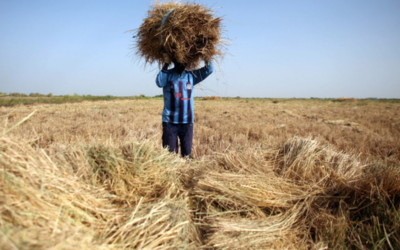Rapid Rice Straw Composting-Rice straw manure is an ordinary manure, which requires three months for complete decomposition. This is a very slow process for those farmers who grow rice crops two or three times a year. The IBS is a rapid composting method, speed up the process with a compost fungus activator, Trichoderma harzianum. The activator is supplemented by soil microbes as a source of waste cellulose decomposers. The number of decomposers and the rate of decomposition so that farmers can use the compost sooner.
For carbon composting for early composting, such as: – rice husk, nitrogen -rich content such as animal manure and the activator Trichoderma harzianum are required. A combination one part of nitrogen substrate to three part carbon is best. If animal manure is getting difficult, it can be replaced with leguminous plants such as azolla and sesbania.

Preparation Method: –
- At the time of harvesting, rice straw is kept on one side of paddy. It later saves labour to have one compost pile for each paddy instead of central heap.
- Rice straw is soaked overnight in irrigation water or moisture in the rain until saturated.
- A simple platform is made in the middle of the paddy ( size is relative to the size of the paddy).
- A layer of saturated rice straw 10-15 centimetre thick is loosely of rice on the platform.
- Above the layer, one or two handful activator is spread out (25 kg / ha).
- Straw is alternatively layered with the activator.
- Until all the straw has been used.
- On the layers of straw, fertilizers and nitrogenous plants are planted. The nitrogen substrate is 15-25% of total composition.
- Compost is covered (with plastic, banana leaves, or coconut husks) and it gets heated within 25 hours.
- The manure should be repeated repeatedly to compensate for evaporation,.
- Manure is left unturned and ready within a month.
- When the pile gets cold, then it is ready to use.
- It is 30% of its original size.
Benefit:-
The benefit of income gains from a healthy crop is the most immediate return. But more importantly, the soil is benefits from continuous use of compost in the long term. Results include improved soil texture and ploughing, better aeration and water-holding capacity, increased fertility and low acidity. Because rice husk is made compost and it is not burnt. It releases less carbon dioxide into the atmosphere. Compost reduces the need for chemical fertilizers. Which contaminate surrounding waters and encourages algae bloom that compete with fish for oxygen. Additionally, as farmer gain self-reliance they becomes less dependent on off-farm inputs.
Possible Drawbacks
- Rapid composting like composting in general.
- Often means more work for the farmer.
- Labor inputs can be reduced by composting in the paddy and in small piles that are easily transportable.
- A reliable supply of T. harzianum is important for facilitate the rapid decomposition process.
- Contaminants reduce the effectiveness of the activator, and can cause skin irritation.
- limited manure supply may result in compost with low N content.

Poonam Singh
Poonam Singh, M.Sc.(Bio-Chemistry), Content writer, Self Shiksha, Lcoatips, Candidviews, Quikpills and Former Research Director at NEEW
